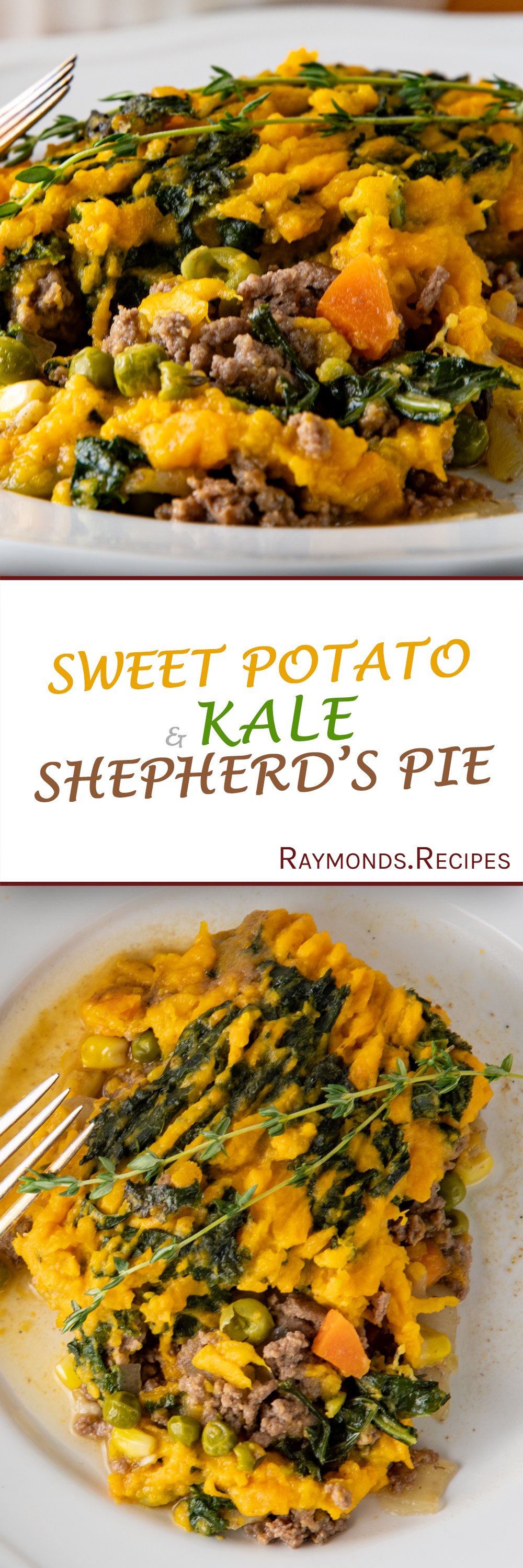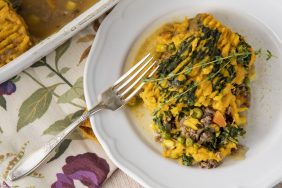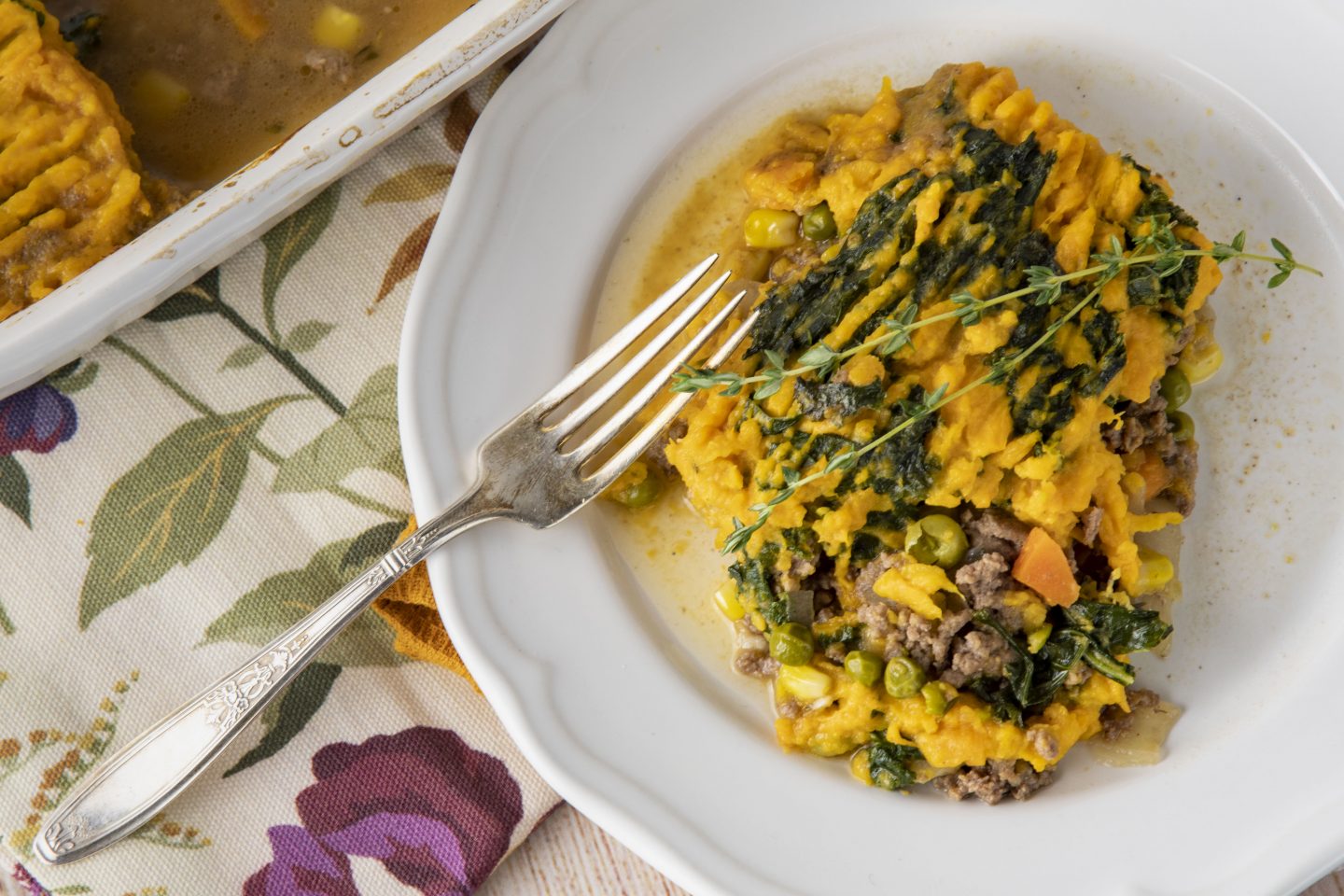Sweet Potato & Kale Shepherd’s Pie

It’s like regular shepherd’s pie, with the healthiness turnt up to 11.
Pro Tip: Tear those kale leaves small or you’ll have clumps of long sauteed leaves and IMO that’s not a fun texture
This recipe features a delicious and comforting Shepherd’s Pie with a flavorful twist. The filling is made with your choice of ground lamb, beef, or pork, combined with diced onions, frozen mixed vegetables, beef broth, thyme, rosemary, and chopped garlic. The mixture is cooked until the meat browns and breaks apart, creating a savory and aromatic base. Worcestershire sauce adds a tangy kick, while a touch of flour helps thicken the filling. The potatoes for the topping are made from sweet potatoes, which are boiled until tender. They are then mashed with butter and sour cream to create a creamy and slightly sweet layer.
To add a nutritious element, the recipe includes kale sautéed with butter until wilted. The kale brings a vibrant green color and an earthy flavor to the dish. The mashed sweet potatoes are combined with sour cream to enhance the creamy texture. Seasoning is adjusted with salt and pepper to taste.
To assemble the Shepherd’s Pie, the meat filling is spread evenly in a baking dish and topped with the mashed sweet potatoes. The dish is baked in the oven until the top is lightly browned and the flavors meld together. Optionally, you can broil the pie for a few minutes to achieve a slightly crispy finish.
In terms of nutrition, this Shepherd’s Pie provides a satisfying and well-rounded meal. It offers approximately 510 calories per serving. The recipe is relatively high in carbohydrates (43g) and protein (18g), while the fat content comes from the meat and added butter. The dish is also rich in vitamins and minerals, including vitamin A, vitamin C, calcium, and iron.
Overall, this Shepherd’s Pie recipe combines the hearty goodness of the meat filling with the creamy sweetness of the mashed sweet potato topping. It’s a wholesome and flavorful dish that can be enjoyed for a comforting family meal.
Nutritional Comparison: Sweet Potatoes vs. potatoes – Choosing the Healthier Option
Sweet potatoes and regular potatoes (often referred to as white potatoes) are both nutritious and versatile root vegetables. While they share similarities in taste and appearance, there are some nutritional differences between the two.
Regular potatoes are sometimes just called “potatoes” for short
Quick Tip!
They are an excellent source of dietary fiber, vitamins A and C, and potassium. The orange flesh of sweet potatoes indicates a high beta-carotene content, which is converted to vitamin A in the body. Vitamin A is important for vision, immune function, and cell growth.
Regular potatoes, on the other hand, are a good source of carbohydrates, vitamin C, and some B vitamins like vitamin B6. They also provide minerals such as potassium and magnesium. However, they are not as rich in fiber or vitamin A as sweet potatoes.
In terms of calorie content, sweet potatoes and regular potatoes are similar. However, the glycemic index (GI) differs between the two. Sweet potatoes have a lower GI, meaning they are digested and absorbed more slowly, resulting in a steadier release of energy and a lower impact on blood sugar levels compared to regular potatoes. This makes sweet potatoes a better choice for individuals with diabetes or those looking to manage their blood sugar levels.
Sweet potatoes are often regarded as a more nutritious option due to their higher nutrient content.
Quick Tip!
Both sweet potatoes and regular potatoes can be part of a healthy diet. The choice between them depends on individual dietary needs and preferences. If you’re looking for a higher vitamin A and fiber content, sweet potatoes are a good choice. Regular potatoes can still be a nutritious option, particularly when prepared in a healthy manner (e.g., boiled or baked instead of deep-fried) and consumed as part of a balanced diet.
It’s worth noting that the nutritional value of potatoes can vary depending on how they are prepared. Deep-frying potatoes or loading them with butter, sour cream, or cheese can significantly increase their calorie and fat content. Opting for healthier cooking methods like baking, boiling, or steaming can help retain more of their nutrients. Additionally, leaving the skin on when consuming potatoes can provide extra fiber and nutrients.
The Nutritional Powerhouse: Exploring the Health Benefits of kale
Kale is a leafy green vegetable that is widely recognized for its exceptional nutritional profile. It belongs to the cruciferous vegetable family, which also includes broccoli, cauliflower, and brussels sprouts. Here are some of the key nutritional benefits of kale:
- Rich in Vitamins: Kale is packed with various vitamins, including vitamin K, vitamin A, vitamin C, vitamin B6, and vitamin E. Vitamin K is particularly abundant in kale and plays a crucial role in blood clotting, bone health, and heart health.
- Excellent Source of Fiber: Kale is a great source of dietary fiber, which is important for maintaining a healthy digestive system, promoting regular bowel movements, and supporting overall gut health.
- High in Antioxidants: Kale is loaded with antioxidants, including flavonoids and carotenoids, which help protect against oxidative stress and reduce the risk of chronic diseases. These antioxidants also have anti-inflammatory properties, which can benefit overall health.
- Contains Minerals: Kale is a good source of minerals such as calcium, potassium, magnesium, and manganese. Calcium is essential for bone health, while potassium is important for heart health and maintaining healthy blood pressure levels.
- Supports Eye Health: Kale is rich in lutein and zeaxanthin, two antioxidants that are particularly beneficial for eye health. These compounds help protect against age-related macular degeneration and promote good vision.
- Low in Calories: Kale is a low-calorie vegetable, making it a great addition to a balanced diet for those watching their calorie intake. It can help you feel satisfied while providing an array of essential nutrients.
Incorporating kale into your diet can be as simple as adding it to salads, soups, smoothies, or stir-fries. It is worth noting that while kale is highly nutritious, it contains goitrogens, naturally occurring substances that can interfere with thyroid function in large amounts. However, consuming reasonable portions of kale as part of a balanced diet is generally safe and offers numerous health benefits.
Shepherd’s Pie vs. Cottage Pie: Origins, Differences, and Traditional Recipes
Shepherd’s pie and cottage pie are both traditional british meat pies with a rich history. Here’s an overview of their origins and the key differences between the two:
Shepherd’s Pie:
Shepherd’s pie is believed to have originated in the late 18th century in the United Kingdom, particularly in Scotland and northern England. Originally, it was known as “cottage pie” or “shepherd’s dish.” The name “shepherd’s pie” became more common in the 20th century.
Key Features:
Filling: Traditionally, shepherd’s pie is made with minced or ground lamb. The lamb is cooked with onions, vegetables (such as carrots and peas), and often flavored with herbs like rosemary or thyme.
topping: The classic topping for shepherd’s pie is mashed potatoes, which are spread over the meat filling. The pie is then baked until the top becomes golden and slightly crispy.
Cottage Pie:
Cottage pie shares a similar history and concept to shepherd’s pie, but with a slight variation in the choice of meat.
Key Features:
Filling: Cottage pie is traditionally made with minced or ground beef instead of lamb. The beef is typically cooked with onions, vegetables (such as carrots and peas), and seasoned with herbs and spices.
Topping: Similar to shepherd’s pie, cottage pie is topped with a layer of mashed potatoes that are spread over the beef filling. The pie is baked until the mashed potatoes form a golden crust.
Key Differences:
The primary difference between the two pies lies in the choice of meat used in the filling. Shepherd’s pie is made with lamb, while cottage pie is made with beef. This distinction is believed to be rooted in regional variations and availability of ingredients.
Over time, the terms “shepherd’s pie” and “cottage pie” have been used interchangeably, leading to some confusion.
Quick Trivia!
It’s worth noting that modern variations of these pies may deviate from the traditional recipes. For example, some recipes may use other meats like turkey or chicken, and the choice of vegetables and seasonings can vary according to personal preference.
Both shepherd’s pie and cottage pie are hearty and comforting dishes that continue to be enjoyed as classic Comfort Food, not only in the United Kingdom but also in various parts of the world.
The Best potatoes for Shepherd’s Pie: Russet, Yukon Gold, Maris Piper, and More
When it comes to choosing potatoes for Shepherd’s Pie, it’s best to opt for varieties that are starchy and make for creamy mashed potatoes. Here are a few types of potatoes commonly used in Shepherd’s Pie:
- Russet Potatoes: Russet potatoes are a popular choice for making mashed potatoes. They have a high starch content, resulting in a fluffy and creamy texture when mashed. Their mild flavor pairs well with the savory filling of Shepherd’s Pie.
- Yukon Gold Potatoes: Yukon Gold potatoes are another excellent option for Shepherd’s Pie. They have a slightly waxy texture and a buttery flavor, which adds richness to the mashed potato topping.
- Maris Piper Potatoes: Maris Piper potatoes are widely used in british cooking and are well-suited for Shepherd’s Pie. They have a creamy texture and a good balance of starch and moisture, resulting in smooth and fluffy mashed potatoes.
- Desiree Potatoes: Desiree potatoes are versatile and make a great choice for Shepherd’s Pie. They have a slightly waxy texture, which helps the mashed potatoes hold their shape while still achieving a creamy consistency.
Ultimately, the choice of potatoes can depend on personal preference and availability. It’s essential to select potatoes that can be easily mashed and create a velvety texture when combined with butter and milk.
Sweet Potato and Sautéed Kale Shepherd’s Pie
Ingredients
The Meat
- 1 lb ground lamb or beef or pork
- 1 onion large , diced
- 2 cups Frozen Vegetables, Mixed
- 1 cup beef broth
- 1 tbsp thyme
- 1/2 tbsp rosemary
- 2 tbsps chopped garlic
The Potatoes
- 2 lbs sweet potato peeled, chopped
- 5 tbsps butter
- 1/3 cup sour cream
- 1 bundle kale leaves only, chopped into 1.5" pieces
- salt
- pepper
- 2 1/2 tbsps worcestershire sauce
- 1 tsp flour
Instructions
- Preheat oven to 375f
- Place sweet potatoes in a large pot, cover with salted water and place on high for 15-20 minutes til potatoes soften.
- preheat a large skillet on high, melt 1 tbsp butter then add lamb, carrots, garlic , thyme, rosemary, onions, salt, pepper, Worcestershire sauce. Cook, stirring til meat breaks apart and begins to brown, 8-10 minutes. Then add vegetables and broth, stir in flour, cover and simmer another 5-8 minutes.
- remove lid and continue to simmer til vegetables soften and liquid reduces by half.
- Drain sweet potatoes into a collander. Return pot to heat, reduce heat to medium-high. Melt remaining butter in pot, add kale and season with salt. Sautee, stirring occasionally til kale is fully wilted. 3-5 minutes.
- Turn off heat to pot. Return potatoes to pot, add sour cream and mash roughly. Taste and adjust flavour with salt and pepper as desired.
- Add lamb to a 13×9 baking dish, cover evenly with potatoes and bake at 375F for 20 minutes. Then optionally broil for another 3-5 minutes
Nutrition





